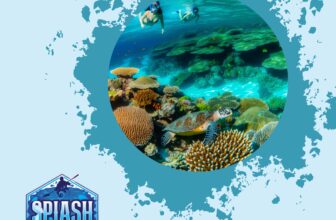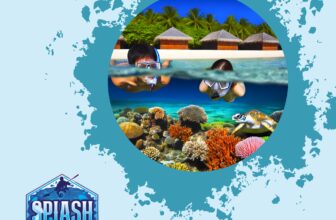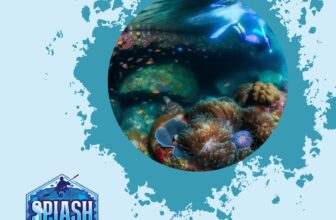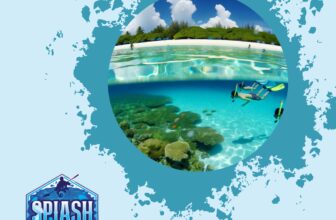
Photography allows us to share the beauty of our underwater world, but it also carries a responsibility. This guide will cover everything you need to know about capturing marine mammals like whales and dolphins while maintaining ethical standards. Whether you're a beginner diver or want to start capturing these majestic creatures, this guide has you covered.
Introduction
The allure of photographing whales and dolphins lies in their majestic presence and the sheer thrill of capturing a fleeting moment in their natural habitat. Imagine the excitement of catching a breaching humpback whale or the playful antics of a pod of dolphins—images like these spark awe and inspiration. However, capturing these moments comes with its own set of challenges and responsibilities.
Marine mammal photography isn't just about snapping a picture; it's about telling a story while respecting the environment and the subjects within it. Ethical marine mammal photography ensures that you capture these incredible creatures without causing them harm or distress. By adhering to ethical principles, not only will you take better photographs, but you'll also contribute positively to marine conservation efforts. In this guide, we will explore how to responsibly photograph whales and dolphins, offering tips and techniques tailored specifically for beginners and those considering diving into this fascinating field.
Understanding Ethical Marine Mammal Photography
Ethical marine mammal photography is all about balancing the excitement of capturing stunning images with the responsibility of respecting the subjects and their environment. At its core, it means ensuring that your photographic activities do not disturb or harm the whales and dolphins you aim to capture. This involves understanding and adhering to guidelines that protect marine life and their habitats.
Core Principles of Ethical Photography
Respecting marine mammals and their natural environments is crucial. These creatures are not just photogenic subjects; they are vital parts of the marine ecosystem. Ethical photography emphasizes minimal intrusion.
- Avoid Chasing or Cornering: Never chase or corner dolphins for a perfect shot. Stress can drive them away from their natural behavior patterns, affect their health, and even lead to long-term ecological impacts.
- Maintain Distance: Keep a safe and respectful distance to avoid causing any distress to the animals.
- Use Proper Equipment: Invest in long-range lenses to capture stunning images without getting too close.
Importance of Ethical Practices
By putting their well-being first, you contribute to the preservation of these incredible animals and their world.
- Health and Behavior: Ethical practices ensure that marine mammals continue their natural behaviors, crucial for their health.
- Ecosystem Balance: Responsible photography helps maintain the ecological balance in marine environments.
Patience and Respect in Photography
Remember, a successful photograph isn't just beautiful; it's also a testament to your commitment to ethical practice.
- Patience: The best shots come from patience and respect, not intrusion and haste.
- Commitment to Ethics: Showcasing ethical practices in your work highlights your dedication to the well-being of marine life.
By following these principles, you can enjoy the thrill of marine mammal photography while ensuring the safety and integrity of the subjects and their habitats.
Pre-Dive Preparations
Research: Know Your Subjects
Before you even think about hopping into the water, it's essential to do your homework. Understanding whale and dolphin behavior is not just about getting better shots; it’s about ensuring your presence doesn’t negatively impact these magnificent creatures. Read up on their migration patterns, feeding habits, and social behaviors. Knowing when and where to find them can save you time and increase your chances of capturing that perfect moment.
Gear Checklist: Essential Equipment
Your underwater photography kit plays a critical role in the quality of your shots and your overall experience. Here's a rundown of what you'll need:
-
Cameras and Lenses: Investing in a good quality camera and lenses suitable for underwater photography is a must. DSLRs and mirrorless cameras with appropriate underwater housings are top choices. Wide-angle lenses are particularly favored for capturing large marine mammals.
-
Protective Waterproof Housings: These are crucial for keeping your camera equipment safe from water damage. Make sure the housings are rated for the depths you plan to dive.
-
Extra Storage and Batteries: Always bring more memory cards and batteries than you think you'll need. You don't want to miss that perfect shot because you ran out of storage or power.
Permits and Regulations: Playing by the Rules
Ethical marine mammal photography also involves adhering to local laws and guidelines. Different areas have their own regulations regarding how close you can get to marine mammals and how long you can stay near them. Some locations might require special permits or licenses. Make it a point to research and obtain all necessary permissions before your dive. Respecting these regulations not only protects marine life but also ensures that you can continue enjoying this hobby without legal repercussions.
Dive Techniques for Capturing Marine Mammals
Once you've prepped and are ready to take the plunge, it's time to focus on the techniques that will help you capture incredible images of marine mammals while being respectful and safe. Here are some key strategies:
Patience and Timing
- Observe Before You Shoot: Marine mammals follow their own schedules, not yours. Monitor their behavior for a while before you even consider taking a shot.
- Anticipate Movements: Waiting and observing can help you anticipate their movements and capture the perfect moment.
- Stay Patient: Patience can mean the difference between a stressed animal and a relaxed, natural shot.
Proper Dive Practices
Approaching Marine Mammals
- Approach Slowly and Calmly: Sudden movements can startle whales and dolphins, causing them to flee or become agitated.
- Use Gentle Movements: Use your fins to gently propel yourself forward rather than kicking aggressively.
Maintaining Safe Distances
- Follow Distance Guidelines: Always adhere to guidelines concerning distance. A common rule is to maintain at least 100 feet from whales and 50 feet from dolphins.
- Back Away Slowly if Needed: If you get closer accidentally, back away slowly. Ethical photography means putting the animal's well-being first.
What to Do If a Whale or Dolphin Approaches You
- Stay Calm and Still: Marine mammals are naturally curious and may approach you. Let the animal control the interaction.
- Avoid Touching: Do not reach out to touch them; instead, enjoy the moment and capture shots without disturbing their natural behavior.
Lighting Techniques
Natural Lighting vs. Artificial Lighting
- Use Sunlight to Your Advantage: Natural lighting is often the most flattering and ethical way to photograph marine mammals. Position yourself so that the sun is behind you for optimal light capture.
- Create Stunning Effects: The sunlight filtering through the water can create breathtaking effects.
Using Strobes and Torches Efficiently
- Use Sparingly: Artificial lighting can be useful, especially in deeper waters where sunlight is limited, but should be used sparingly.
- Highlight Specific Features: Torches can be used to highlight specific features but should be employed with caution.
- Minimize Disturbances: Remember, bright flashes and continuous lighting can disturb marine life.
By incorporating these dive techniques into your underwater adventures, you'll be able to ethically capture the beauty of whales and dolphins while respecting their natural habitats. Happy diving!
Post-Dive Workflow
Organizing Your Shots
After your dive, the first step is to organize your shots. Create a system that works best for you – whether it’s by date, location, or subject. This will make it easier to find specific photos later on. Transfer your images from your camera to your computer as soon as possible. Use reliable storage options like external hard drives or cloud services to create backups. Remember, good organization is key to efficient post-processing.
Basic Editing Techniques
The first step in transforming your raw shots into stunning images is understanding basic editing software, such as Adobe Lightroom or Photoshop. Start with these foundational practices:
- Color Correction: Underwater photos often appear blue or green. Adjust the white balance to restore natural colors.
- Exposure Adjustments: Correct overexposed or underexposed areas to reveal hidden details.
- Cropping: Enhance your composition by trimming off unnecessary parts of the image.
Advanced Editing Workflow
Once you’re comfortable with the basics, delve into more advanced editing techniques:
- Image Enhancement: Use tools like clarity and sharpness to bring out the textures and details of marine mammals.
- Noise Reduction: Underwater photos can be noisy due to low light conditions. Use noise reduction tools sparingly to maintain image integrity.
- Selective Adjustments: Employ masks and adjustment layers to edit specific parts of your photo without affecting the whole image. This is especially useful for spotlighting features like the eyes or patterns on a dolphin’s skin.
- Healing and Cloning: Remove any distracting elements such as bubbles or particles using healing and cloning tools.
Specialized Tools
For those keen on pushing their work further, specialized software such as Capture One or Nik Collection offers advanced color grading and fine-tuning capabilities. Plugins and presets can also expedite your workflow, giving your images a professional touch with minimal effort.
By mastering these post-dive workflow steps, you'll not only produce better images but also deepen your appreciation of the incredible marine mammals you photograph. Happy editing!
Ethical Considerations in Image Editing
Editing your photos is a natural part of the post-dive process, but it's essential to do so ethically to maintain the integrity of your images and the trust of your audience. Here are some key points to keep in mind:
Avoiding Misrepresentation
When you're editing photos of marine mammals, it's crucial to preserve their natural appearance. Over-editing can lead to images that misrepresent the animals and the underwater environment. Here are a few guidelines to avoid misrepresentation:
-
Natural Colors:
- Underwater photography often suffers from color loss due to the water's filtering effects. While color correction is necessary, ensure that you don't overdo it. The goal is to bring back the natural hues, not to create exaggerated, otherworldly colors.
-
Shape and Size:
- Resist the temptation to alter the shape or size of the animals. Stretching a whale to make it appear larger or slimming down a dolphin for aesthetics can lead to unrealistic portrayals.
-
Context Preservation:
- Keep the surrounding environment as true-to-life as possible. Removing or adding elements in the background can provide a false narrative about the animals' habitat and behaviors.
Transparency
Transparency is a cornerstone of ethical editing. Always inform your viewers when significant edits have been made to your photos. This helps maintain credibility and trust within the photography community. Here’s how you can practice transparency:
-
Editing Disclosure:
- In your photo descriptions or captions, briefly mention any notable edits, especially those that alter the natural scene. For example, "Color corrected and light enhanced" informs the viewers that adjustments were made.
-
Before and After Comparisons:
- Sharing before and after versions of your photos can be educational and enlightening for your audience. It provides insight into your editing process and demonstrates your commitment to authenticity.
-
Minimal Manipulation:
- Strive for minimal manipulation when editing. Simple adjustments like brightness, contrast, and minor color corrections can enhance your photos without distorting reality.
By following these ethical guidelines, you'll be contributing to a more honest and respectful depiction of marine mammals. Not only does this practice honor the subjects of your photography, but it also promotes a responsible and trustworthy approach within the underwater photography community.
Photography Tips from the Experts
Navigating the deep blue to capture that perfect shot of a whale or dolphin isn't just about having the right gear—it's an art form honed through experience. We reached out to some professional underwater photographers to gather their wisdom and tricks of the trade. Here's what they had to say.
Insights from Rachel McAdams, Underwater Photographer
"One of the best pieces of advice I can give is to know your subject. Spend time understanding the behaviors and patterns of the marine mammals you want to photograph. This not only helps in anticipating their movements but also ensures that you capture their natural and most honest moments without causing them stress. Patience is key—sometimes you might have to float motionless for a while, waiting for the perfect opportunity."
Rachel also emphasizes the importance of the right equipment. "Invest in a good-quality wide-angle lens and ensure your camera housing is secure. A leak detector in your housing can save you a lot of trouble."
Tips from John Doe, Marine Conservationist and Photographer
John brings a unique perspective as someone deeply involved in marine conservation. "Always prioritize the well-being of the animals over getting the shot. Maintain proper distance—don’t chase or corner them. Use longer lenses if you need closer shots; this minimizes any intrusion into their space."
He chuckles, "And remember, the ocean is unpredictable. Sometimes, the best photographs happen when you least expect them. Stay flexible and ready to adjust your plans."
Ashley Green's Lighting Advice
Ashley, known for her stunning underwater shots, shares, "Lighting underwater is tricky. The deeper you go, the less natural light you have. Utilize ambient light as much as possible for a more natural look. If using strobes, make sure to diffuse them to avoid startling the animals and to get softer, more natural lighting."
Ashley also advises practicing good buoyancy control. "Steady hands come from a steady body. Good buoyancy not only helps you manage your shots better but also reduces the risk of damaging the fragile underwater environment."
Practical Anecdote from Paul Watson
Paul Watson recalls an unforgettable moment, "I once spent four hours in the water waiting for a pod of dolphins. Just when I thought they had moved on, they appeared right below me, curious and playful. Those moments of incredible interaction only happen when you respect their space and show patience."
Final Thoughts
From these seasoned photographers, the underlying themes are clear: respect, patience, and preparedness. Ethical marine mammal photography is about more than just capturing a picture—it's about creating a meaningful connection with these majestic creatures and showcasing their beauty in a responsible way.
So, strap on your gear, arm yourself with knowledge, and dive in. The ocean awaits, full of stories to tell through your lens.
Practice Makes Perfect
If there’s one thing that seasoned underwater photographers will tell you, it’s that skill develops with practice and experience. Like any other craft, capturing marine mammals in their natural habitat requires both time and patience to hone. Don’t be disheartened if your first few dives don’t result in award-winning shots. Consistent practice is your best path to improvement.
Dive, Shoot, Reflect, Repeat
Every dive gives you the opportunity to learn something new, whether it’s about lighting, angles, or the behavior of marine mammals. After each dive, take the time to review your shots and reflect on what worked and what didn’t. Were you too close or too far from your subject? Was the lighting satisfactory? Did you manage to capture any natural behaviors? Analyzing your photos will help you identify areas for improvement and refine your techniques.
Workshops and Courses
If you’re serious about upping your game, consider enrolling in underwater photography workshops and courses. These are invaluable for gaining insights from experienced professionals and offer hands-on practice in controlled environments. They also provide opportunities to receive constructive feedback on your work. Here are a few top-rated workshops around the world you might want to consider:
- SplashSpiral's Underwater Photography Workshop in the Maldives: Known for its clear waters and diverse marine life.
- Bali Underwater Photography Bootcamp: Offers a mix of theory and practical dives.
- Coral Triangle Photography Expedition: Perfect for those wanting to combine travel with intensive photography training.
You can find a comprehensive list of recommended workshops here.
Building Your Own Portfolio
Over time, as you amass a collection of photographs, begin compiling them into a portfolio. This not only showcases your progression but can also serve as a useful tool if you wish to pursue this hobby professionally. Share your work on social media, photography forums, and with your local dive community to get feedback and build a network of like-minded individuals.
Remember, practice is not just about improving your technical skills. It's also about developing an intuitive understanding of marine life and learning how to capture spontaneous moments without causing distress or harm to the animals. Embrace the journey, stay patient, and keep diving!
Safety and Responsibility
Photography in the underwater realm isn't without its risks. Ensuring your own safety is paramount. Below are key aspects to consider for a safe and responsible underwater photography experience.
Ensuring Your Own Safety While Diving
Safety starts with proper preparation and knowledge.
-
Proper Training:
- Ensure you are a certified diver.
- Undergo training specific to underwater photography.
- Learn to manage buoyancy and navigate underwater environments.
-
Equipment Check:
- Regularly inspect your camera, waterproof housing, and diving gear.
- Avoid malfunctions that can be dangerous and jeopardize your equipment.
-
Know Your Limits:
-
Don't exceed your comfort level in depth or current conditions.
-
Maintain your physical stamina.
-
Always dive with a buddy and use clear communication methods, such as hand signals or underwater communication devices.
- Monitor Air Supply and Decompression Limits:
- Keep tabs on your air levels and dive time using a dive computer.
- Avoid getting too engrossed in photography to prevent losing track of time and depth.
The Role of Photographers in Ocean Conservation and Marine Protection
As photographers, we have a unique responsibility in ocean conservation. Here's how to approach it responsibly:
-
Avoid Disturbing Marine Life:
- Do not chase, touch, or encroach on marine mammals and their habitats.
- Capture images from an appropriate distance using a zoom lens if necessary to avoid stressing or harming the creatures.
-
Respect Local Guidelines:
- Adhere to regional regulations designed to protect marine species.
- Positively contribute to conservation efforts by following these rules.
-
Advocate for Marine Environment:
-
Use your platform to promote sustainable practices.
-
Educate others about the importance of ocean health.
-
Share the stories behind your photos to encourage others to respect and protect marine life.
By prioritizing safety and acting responsibly, you safeguard your own life and help preserve the delicate balance of our underwater ecosystems.
Conclusion
We've journeyed through the essentials of capturing stunning images of whales and dolphins while prioritizing ethical practice. From understanding respectful interaction with these majestic creatures to diving techniques that prioritize their well-being, we've covered core principles that every beginner photographer-diver should know. Adopting these practices not only supports marine conservation but also enriches your underwater photography experience.
Remember, every dive is a learning opportunity. Stay curious, respect the marine environment, and continuously refine your skills. Ethical marine mammal photography is more than just capturing beautiful images; it's about fostering a deeper connection with our ocean companions while ensuring their world remains undisturbed.
Ready to dive in and start your journey? Enhance your skills with these additional resources:
Keep exploring, stay ethical, and happy diving!







